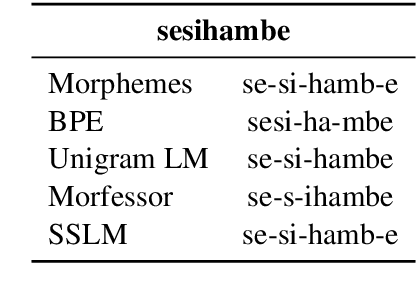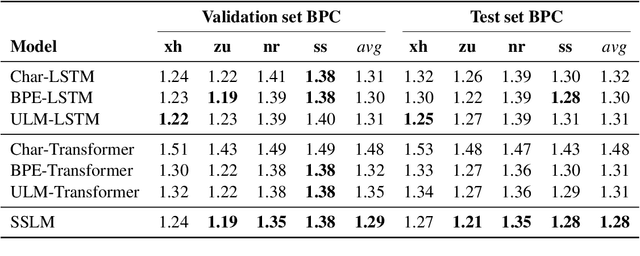Francois Meyer
Neural Morphological Tagging for Nguni Languages
May 19, 2025Abstract:Morphological parsing is the task of decomposing words into morphemes, the smallest units of meaning in a language, and labelling their grammatical roles. It is a particularly challenging task for agglutinative languages, such as the Nguni languages of South Africa, which construct words by concatenating multiple morphemes. A morphological parsing system can be framed as a pipeline with two separate components, a segmenter followed by a tagger. This paper investigates the use of neural methods to build morphological taggers for the four Nguni languages. We compare two classes of approaches: training neural sequence labellers (LSTMs and neural CRFs) from scratch and finetuning pretrained language models. We compare performance across these two categories, as well as to a traditional rule-based morphological parser. Neural taggers comfortably outperform the rule-based baseline and models trained from scratch tend to outperform pretrained models. We also compare parsing results across different upstream segmenters and with varying linguistic input features. Our findings confirm the viability of employing neural taggers based on pre-existing morphological segmenters for the Nguni languages.
Designing and Contextualising Probes for African Languages
May 15, 2025Abstract:Pretrained language models (PLMs) for African languages are continually improving, but the reasons behind these advances remain unclear. This paper presents the first systematic investigation into probing PLMs for linguistic knowledge about African languages. We train layer-wise probes for six typologically diverse African languages to analyse how linguistic features are distributed. We also design control tasks, a way to interpret probe performance, for the MasakhaPOS dataset. We find PLMs adapted for African languages to encode more linguistic information about target languages than massively multilingual PLMs. Our results reaffirm previous findings that token-level syntactic information concentrates in middle-to-last layers, while sentence-level semantic information is distributed across all layers. Through control tasks and probing baselines, we confirm that performance reflects the internal knowledge of PLMs rather than probe memorisation. Our study applies established interpretability techniques to African-language PLMs. In doing so, we highlight the internal mechanisms underlying the success of strategies like active learning and multilingual adaptation.
BabyLMs for isiXhosa: Data-Efficient Language Modelling in a Low-Resource Context
Jan 07, 2025



Abstract:The BabyLM challenge called on participants to develop sample-efficient language models. Submissions were pretrained on a fixed English corpus, limited to the amount of words children are exposed to in development (<100m). The challenge produced new architectures for data-efficient language modelling, which outperformed models trained on trillions of words. This is promising for low-resource languages, where available corpora are limited to much less than 100m words. In this paper, we explore the potential of BabyLMs for low-resource languages, using the isiXhosa language as a case study. We pretrain two BabyLM architectures, ELC-BERT and MLSM, on an isiXhosa corpus. They outperform a vanilla pretrained model on POS tagging and NER, achieving notable gains (+3.2 F1) for the latter. In some instances, the BabyLMs even outperform XLM-R. Our findings show that data-efficient models are viable for low-resource languages, but highlight the continued importance, and lack of, high-quality pretraining data. Finally, we visually analyse how BabyLM architectures encode isiXhosa.
A Systematic Analysis of Subwords and Cross-Lingual Transfer in Multilingual Translation
Mar 29, 2024



Abstract:Multilingual modelling can improve machine translation for low-resource languages, partly through shared subword representations. This paper studies the role of subword segmentation in cross-lingual transfer. We systematically compare the efficacy of several subword methods in promoting synergy and preventing interference across different linguistic typologies. Our findings show that subword regularisation boosts synergy in multilingual modelling, whereas BPE more effectively facilitates transfer during cross-lingual fine-tuning. Notably, our results suggest that differences in orthographic word boundary conventions (the morphological granularity of written words) may impede cross-lingual transfer more significantly than linguistic unrelatedness. Our study confirms that decisions around subword modelling can be key to optimising the benefits of multilingual modelling.
Triples-to-isiXhosa (T2X): Addressing the Challenges of Low-Resource Agglutinative Data-to-Text Generation
Mar 12, 2024



Abstract:Most data-to-text datasets are for English, so the difficulties of modelling data-to-text for low-resource languages are largely unexplored. In this paper we tackle data-to-text for isiXhosa, which is low-resource and agglutinative. We introduce Triples-to-isiXhosa (T2X), a new dataset based on a subset of WebNLG, which presents a new linguistic context that shifts modelling demands to subword-driven techniques. We also develop an evaluation framework for T2X that measures how accurately generated text describes the data. This enables future users of T2X to go beyond surface-level metrics in evaluation. On the modelling side we explore two classes of methods - dedicated data-to-text models trained from scratch and pretrained language models (PLMs). We propose a new dedicated architecture aimed at agglutinative data-to-text, the Subword Segmental Pointer Generator (SSPG). It jointly learns to segment words and copy entities, and outperforms existing dedicated models for 2 agglutinative languages (isiXhosa and Finnish). We investigate pretrained solutions for T2X, which reveals that standard PLMs come up short. Fine-tuning machine translation models emerges as the best method overall. These findings underscore the distinct challenge presented by T2X: neither well-established data-to-text architectures nor customary pretrained methodologies prove optimal. We conclude with a qualitative analysis of generation errors and an ablation study.
Subword Segmental Machine Translation: Unifying Segmentation and Target Sentence Generation
May 11, 2023Abstract:Subword segmenters like BPE operate as a preprocessing step in neural machine translation and other (conditional) language models. They are applied to datasets before training, so translation or text generation quality relies on the quality of segmentations. We propose a departure from this paradigm, called subword segmental machine translation (SSMT). SSMT unifies subword segmentation and MT in a single trainable model. It learns to segment target sentence words while jointly learning to generate target sentences. To use SSMT during inference we propose dynamic decoding, a text generation algorithm that adapts segmentations as it generates translations. Experiments across 6 translation directions show that SSMT improves chrF scores for morphologically rich agglutinative languages. Gains are strongest in the very low-resource scenario. SSMT also learns subwords that are closer to morphemes compared to baselines and proves more robust on a test set constructed for evaluating morphological compositional generalisation.
Subword Segmental Language Modelling for Nguni Languages
Oct 12, 2022



Abstract:Subwords have become the standard units of text in NLP, enabling efficient open-vocabulary models. With algorithms like byte-pair encoding (BPE), subword segmentation is viewed as a preprocessing step applied to the corpus before training. This can lead to sub-optimal segmentations for low-resource languages with complex morphologies. We propose a subword segmental language model (SSLM) that learns how to segment words while being trained for autoregressive language modelling. By unifying subword segmentation and language modelling, our model learns subwords that optimise LM performance. We train our model on the 4 Nguni languages of South Africa. These are low-resource agglutinative languages, so subword information is critical. As an LM, SSLM outperforms existing approaches such as BPE-based models on average across the 4 languages. Furthermore, it outperforms standard subword segmenters on unsupervised morphological segmentation. We also train our model as a word-level sequence model, resulting in an unsupervised morphological segmenter that outperforms existing methods by a large margin for all 4 languages. Our results show that learning subword segmentation is an effective alternative to existing subword segmenters, enabling the model to discover morpheme-like subwords that improve its LM capabilities.
Modelling Lexical Ambiguity with Density Matrices
Oct 12, 2020



Abstract:Words can have multiple senses. Compositional distributional models of meaning have been argued to deal well with finer shades of meaning variation known as polysemy, but are not so well equipped to handle word senses that are etymologically unrelated, or homonymy. Moving from vectors to density matrices allows us to encode a probability distribution over different senses of a word, and can also be accommodated within a compositional distributional model of meaning. In this paper we present three new neural models for learning density matrices from a corpus, and test their ability to discriminate between word senses on a range of compositional datasets. When paired with a particular composition method, our best model outperforms existing vector-based compositional models as well as strong sentence encoders.
 Add to Chrome
Add to Chrome Add to Firefox
Add to Firefox Add to Edge
Add to Edge